https://www.freepressjournal.in/analysis/india-plunder-part-ii-how-finance-commission-weightages-were-tweaked-to-promote-profligacy-and-irresponsibilityhttps://www.freepressjournal.in/analysis/india-plunder-part-ii-how-finance-commission-weightages-were-tweaked-to-promote-profligacy-and-irresponsibility
India plunder – Part II:
Tweaking rules to promote abet plunder through profligacy and irresponsibility
RN Bhaskar – Sept 10, 2020
==================
The other parts of this series can be found at
http://www.asiaconverge.com/2020/09/the-plunder-series/
==========================
Except for brief periods, much of North Indian history has been one of invasions, and petty infighting. Few empires survived for more than a few hundred years. The largest ‘national’ empires were those of the Guptas and the Mauryas. But the Gupta empire survived for 250 years, and the Mauryan empire for less than 200 years. The Chalukyas which spanned 600 years was more to the West and the South. Ditto with the Marathas.
Almost all the smaller satraps usually agreed to accept a negotiated amount from the conquerors. This took away their appetite for dignity, fiscal discipline or even self-governance.
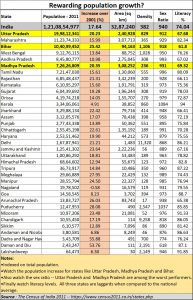 This was a far cry from the Southern states that had learnt to stay ‘free’ for almost 2000 years. The Chola dynasty ruled – over varying sizes of empires – for almost 1600 years. Eventually, the South too capitulated to the British. But for almost 2,000 years, these were the territories that earned gold for the territory known as India.
This was a far cry from the Southern states that had learnt to stay ‘free’ for almost 2000 years. The Chola dynasty ruled – over varying sizes of empires – for almost 1600 years. Eventually, the South too capitulated to the British. But for almost 2,000 years, these were the territories that earned gold for the territory known as India.
They even ‘bankrupted’ the vaults of Rome. Eventually the Roman empire was compelled to debase its own currency and use lower grade metals instead of gold coins (Mukund, Kanakalatha. The World of the Tamil Merchant. Penguin Books Ltd.). Incidentally, the gold coins that the Kushans issued in India were actually made from the melting of Roman coins earned by South India and then making coins with Kanishka’s face (https://www.youtube.com/watch?v=eN0aw6AeKUE).
The wheel of Fortune has begun turning. States that had not learnt how to govern themselves are now trying to assert their right to govern (even over states that ruled themselves for over a thousand years). For them, access to funds has become a birthright. They don’t think they need to earn this money. Consequently, money that is earned by states in the south and the West are transferred to the northern states, often through (guileful) legislation.
There is no doubt that of all states in India, Uttar Pradesh, Madhya Pradesh, and Bihar are the some of the worst performers (see table). Check their population growth – way above the national average. Observe their gender ratio which is so low that it points to female foeticide and the myopic dogmatism of male domination. This is also due to the low literacy levels in these sates – they too are below the national average.
The combination of these terrible parameters should have been cause enough for planners to create a set of disincentives — for states increasing population, for not improving the sex ratio or not improving literacy levels. But when these disincentives are waived, and incentives are granted instead, you can be sure that there is mischief afoot.
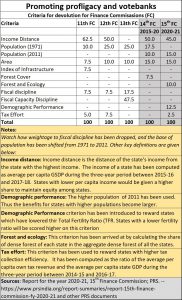 This is precisely what proposals mooted by successive Finance Commissions (FCs) suggest (see table). FCs are created by the Parliament to suggest how government funds should be disbursed to the states of India (https://www.prsindia.org/report-summaries/report-15th-finance-commission-fy-2020-21).
This is precisely what proposals mooted by successive Finance Commissions (FCs) suggest (see table). FCs are created by the Parliament to suggest how government funds should be disbursed to the states of India (https://www.prsindia.org/report-summaries/report-15th-finance-commission-fy-2020-21).
Normally, there are two principles that should be uppermost in the minds of policy makers. First, the states that bring in more money should be rewarded and incentivised to generate even more wealth. Second, needy states should be helped out, but with caveats. This help should be forthcoming only if they meet developmental goals – like reducing population, improving the sex ratio (or preventing the obnoxious practice of female foeticide) or improving literacy levels.
But this is precisely what the FCs have not done. Each successive FC has tilted the scales in favour of populism, rather than good governance.
Watch, for instance, how the condition of fiscal discipline was dropped by the last two FCs.
Observe how the weightage of area has been increased, giving larger states bigger benefits.
Income distance, which had the largest weightage in the 11th FC has been diluted by successive FCs. As the notes to the table explain, income distance is the distance of the state’s income from the state with the highest income. States with lower per capita income are then given a higher share to maintain equity among states.
But UP and MP have shown that there is money in the states, yet people in these states remain poor, Per capita income can be artificially kept at low levels, by exploiting farmers, and not paying them their fair dues. For instance, UP could easily have encouraged milk cooperatives, thus ensuring that dairy farmers got Rs.26 per litre of milk instead of Rs.18 (or lower) that middlemen offer them currently. The basic cost of maintaining cattle is around Rs.14 a litre. At Rs.18, the farmer gets a surplus of barely Rs.4 a litre. At Rs.26, his income would have trebled. But the farmer’s income is kept low by ensuring that well-managed milk cooperatives do not take roots. Bihar has begun promoting milk cooperatives. But not UP or MP.
Or take the case of sugarcane – Maharashtra and UP account for almost 80% of national sugarcane production. While the sugarcane production is controlled by cooperatives in Maharashtra, it is with the private sector in UP. While Maharashtra’s cooperatives are no paragon on virtue or financial propriety (http://www.asiaconverge.com/2018/11/poor-water-management-in-maharashtra-is-criminal/), UP has proved to be the bigger exploiter of farmers. As the 2019-20 sugar season (October-September) draws to a close, around Rs 16,000 crore remains to be paid to farmers for sugarcane purchased. Maharashtra’s arrears are around Rs.5,000 crore. UP’s is around Rs 11,000 crore (https://www.business-standard.com/article/economy-policy/why-sugar-farmers-remain-under-the-stress-of-mounting-payment-dues-120090201454_1.html) . What this means is that per capita income can be kept extremely low, if exploitation by politically aligned powerful interests is rampant.
That can also explain why many of the wealthiest politician-linked scamsters appear to come from these states. The misappropriation of wealth by bureaucrats is quite well documented in MP. There is the case of Jitendra Soni who is alleged to have ensured that the municipal corporation overlooked every building norm, land grab or illegal construction for over two decades. Soni accumulated an empire worth Rs 800 crore (https://thewire.in/politics/mp-is-a-prime-example-of-a-corrupt-administration-that-flexes-when-convenient). Then there is the IAS couple which had disproportionate assets worth Rs. 350 crore and recovery of Rs. 3 crores in cash (https://www.thehindu.com/news/national/other-states/grafttainted-ias-couple-in-madhya-pradesh-sacked/article6237918.ece). Just do a Duckduckgo.com or google.com search for MP, IAS men raided. The list is just too large to be reproduced here.
And, remember, that this does not include the Vyapam scam in which (by June 2015) more than 2,000 people had been arrested in connection with the scam. This scam could involve thousands of crores and has already taken the lives of almost anyone who came close to unearthing the scamsters. After being indicted by the Supreme Court (https://timesofindia.indiatimes.com/city/bhopal/madhya-pradesh-govt-to-re-open-1200-complaints-of-vyapam-scam/articleshow/68832168.cms) the government has promised to re-investigate the issues involved.
The crimes of UP are sleazier. They involve politicians who have abused underaged girls in orphanages (The cases that can be viewed at https://news.yahoo.com/dozens-girls-india-abuse-shelter-contract-coronavirus-143845081.html and https://www.hindustantimes.com/lucknow/uttar-pradesh-girl-drugged-gang-raped-forced-into-prostitution-in-varanasi/story-BLW9R3ll9H3Az6PxZLe4oM.html are just two instances). The numbers of pedophilia cases may be higher for Maharashtra, but anecdotal information suggests that it is rampant in UP, yet often goes unreported. In any case, there is enough evidence to suggest (http://www.asiaconverge.com/2020/08/government-plunder-productive-states-in-india/) that UP has found ingenious ways to defraud the exchequer to favour politicians and those close to them.
Also observe how the FCs changed the norm for the population baseline by changing it from the 1971 Census to the 2011 Census. That benefitted UP and MP immensely. This has been compounded by granting a higher weightage even to the 2011 Census numbers.
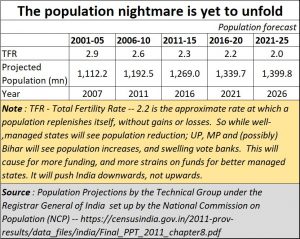 Clearly, this is an incentive to states like UP, MP and (possibly) Bihar to produce more children to get a greater share of funds. And politicians, ever aware of how more people translate into more votes, will be ever willing to let financial allocations go their way. It will be the triumph of populism over good sense or even basic economics.
Clearly, this is an incentive to states like UP, MP and (possibly) Bihar to produce more children to get a greater share of funds. And politicians, ever aware of how more people translate into more votes, will be ever willing to let financial allocations go their way. It will be the triumph of populism over good sense or even basic economics.
The population issue will become a huge crisis if one considers population forecasts of the technical committee which submitted its findings recently (see table). It shows population growth falling below the replacement rate of 2.2% (https://censusindia.gov.in/2011-prov-results/data_files/india/Final_PPT_2011_chapter8.pdf).
Much of this decline will come from the South and the West. This will mean that the share of the North will only increase in the national population mix.
Worse, a declining population – below the replacement rate — in the South and West will mean higher costs for medicare and care for the aged. That will also be the time, these states will need more money to take care of themselves, and the strains of having to feed an irresponsible North will begin to chafe further.
This is extremely worrisome because within a few years India will begin work on the reorganisation of Lok Sabha constituencies based on population. Obviously states which have been doing better in terms on human development index (HDI) and population control, will lose out to UP, Bihar and MP. Unless the courts are invoked right away to prevent this sleight of hand, India could be plundered once again by invaders from the North.
That is what the Southern States are worried about. With more money, more votes and shriller demands for more seats, such demands and allocations could change the national character of India, and hence of its Constitution as well. Not surprisingly, there have been such fears expressed, time and again (https://timesofindia.indiatimes.com/business/india-business/southern-states-biggest-losers-in-new-tax-sharing-formula/articleshow/73861255.cms).
That is why the the population parameter used by the FC has been criticised by governments of most Southern states (https://www.thenewsminute.com/article/explained-how-south-states-stand-lose-15th-finance-commission-recommendations-117406) . They rightly point out that the combined population of the Bihar, Uttar Pradesh, Madhya Pradesh, Rajasthan, and Jharkhand is 47.8 crore. This is over 39.48% of India’s total population and is spread over 32.4% of the country’s area, as per the 2011 Census. The FC has actually ensured that these states are rewarded through the weightages given to population and area (https://www.civilsdaily.com/burning-issue-15th-finance-commission-and-its-recommendations-part-ii/)
On the other hand, the southern states of Tamil Nadu, Kerala, Karnataka and undivided Andhra Pradesh are home to only 20.75% of the population living in 19.34% of the area, with a huge share of the taxes paid to the government (more on the taxes angle will be covered in the next article in this series). This means that the terms decided by the FC are loaded against the more progressive (and prosperous) southern states. That is why, the apex court, instead of spending time deliberating over how its own dignity should be protected, should now move quickly to save the dignity of India, and of its wealth generating people.
Obviously, one can expect the howls of protest by the wealth generators to grow shriller. If left unchecked, it will lead to demands for the South and West to seek greater autonomy from the rest of India. The first stirrings have already begun, with non-BJP states demanding a revision of the center’s stand on GST. It is no coincidence that most non-BJP states are those in the South and in the West. The polarization could become worse.
If the government does not prevent this plunder of taxpayer funds by northern states (from funds generated by the tax paying states in the south and the west), expect big trouble ahead.





























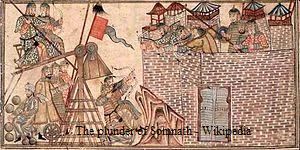






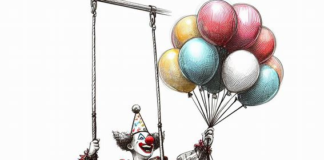
COMMENTS